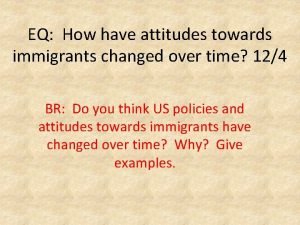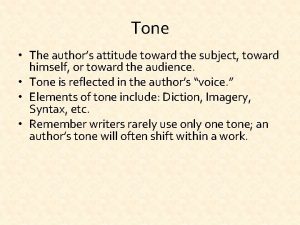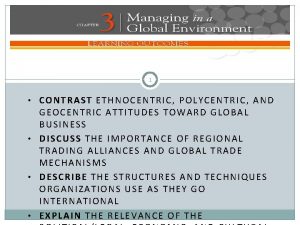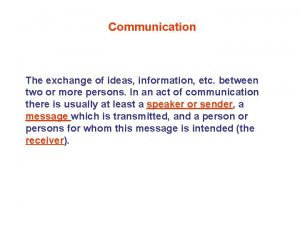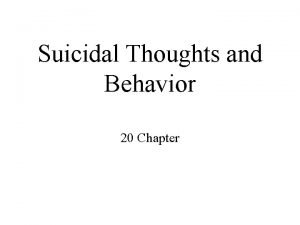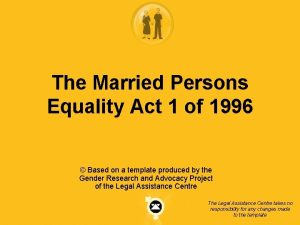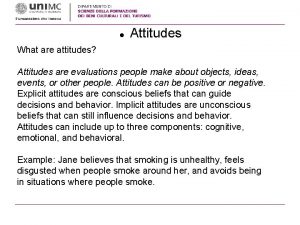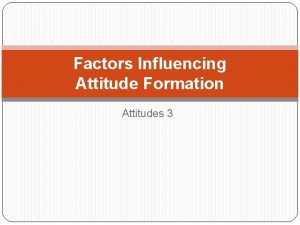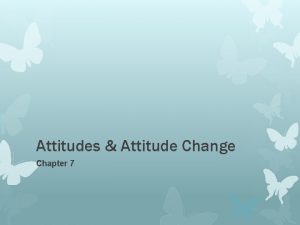Measuring Attitudes A persons attitude towards an attitude












- Slides: 12

Measuring Attitudes üA person’s attitude towards an attitude object may be measured in two ways. üObseravtion of behavioural signals üHighly positive or negative attitudes may manifest themselves in an individual becoming over aroused, including changes to heart rate, body language e. g. failing to make eye contact. üHard to measure and rarely more than a general indicator

Questionnaires � Far more common method � Takes the form of an attitude scale that attempts to investigate an individual’s attitudes towards a range of objects by asking them to respond to a set of statements e. g ranging from strongly agreestrongly disagree � This is known as a Likert scale

Why is it necessary to form good attitudes? � Attitudes are a predictor of behaviour � Positive attitudes will often lead to positive behaviours. � Give examples of this � Participating in physical activity � Showing sportsmanship � Good attitudes are socially valued � They conform to preferred norms and allow individuals to feel valued and be accepted into a group. � Socialisation-we learn to conform to the ways of our society

Changing Attitudes � Is it possible? ? � Depends on how specific an attitude is. � There are two main methods of changing attitudes � Persuasive communication � An active, non-coercive attempt to reinforce, modify or change the attitude of others. � Cognitive dissonance � Tension resulting from having contradictory thoughts, beliefs or emotions about an attitude object

The effectiveness of persuasive communication depends on three factors which interlinked � The persuader � Status (in the eyes of the person receiving the message) a person with higher status is more likely to persuade � Popularity � Role models such as high profile performer can be more effective � Credibility � Linked to status but also to feelings of trustworthiness and whether they have given accurate or helpful advice in the past � Social or cultural background � A wide difference between backgrounds is negative

The message � The accuracy of the message � Is it obviously correct? � The delivery of the message � Is it stated with confidence and enthusiasm � The clarity of the message � Is the argument well constructed and logical? � Is the message logical and factual, appealing to intellect or is it emotional, appealing to feelings of loyalty, duty and responsibility?

The Receiver � Are they ready for the message � Able to understand the arguments in terms of their own emotional, intellectual and educational development � How strongly held is the current attitude, how persuadable is the receiver, why to they hold their current feelings and beliefs? � Are they motivated to change or at the very least open to the possibility of change? � Pushing too hard can make someone defensive and more resistant to change.

Variables affecting persuasion Peoples perceptions of Who What (source) (message) Status Accurate Credibility Argument Expertise Presentation Trust Emotion Motives Background To whom Where (Receiver) (Context) Education commitment

Cognitive Dissonance � Theory developed by Leon Festinger (1953)Theory states that indiviuals like to be consistent in what they do, feel and believe. � If they do something that goes against their beliefs, or if they encounter new knowledge or feelings that are counter to their current state of mind, they feel uncomfortable. � They feel dissonance (a lack of consistency). � If all three components of attitude (CAB) are consistent then a person feels more comfortable with their behaviour

Example of Cognitive dissonance A group of boys is being introduced to dance in PE but they have a poor attitude towards it and are not cooperative. � Cognitive: Dance is not highly thought of by their peers, may believe it is for girls and father makes disparaging remarks about male dancers on TV. � Affective: They may have tried dance before and did not enjoy it � Behavioural: they may or may not have tried dance before and refuse to try it now. � The boys refusal to try dance is consistent with the other components so they feel more comfortable not trying. � To improve the situation the teacher must try to create some level of dissonance and change one of the components �

Changing attitude through dissonance � Cognitive: change their knowledge by bringing in high status dancer to demonstrate, showing different forms of dance like street and breakdance moves. Emphasise benefits such as strength and muscle tone. � Affective: engineer a situation where the boys are likely to enjoy a dance experience e. g. a dance off with popular music, positive reinforcement to all � Behavioural: use rewards and incentives to get them to have a go. � If you can change one component the individual is motivated to at least try and change the others to return to a feeling of consistency

Evaluation of cognitive dissonance theory � Criticisms include; � Being too simplistic and not taking into account an individual’s personality, motivation and whether they have a need for consistency. � Persuasive communication and cognitive dissonance are both useful concepts to understand the cause of a negative attitude � Attitude change is a very complex concept and without the intrinsic desire to change it is very difficult to achieve this.
 One person's trash is another person's treasure
One person's trash is another person's treasure How have attitudes towards immigrants changed
How have attitudes towards immigrants changed Attitude of teachers towards teaching profession
Attitude of teachers towards teaching profession The authors attitude toward the subject
The authors attitude toward the subject Author attitude
Author attitude Is the author's attitude towards the subject
Is the author's attitude towards the subject What is polycentric attitude
What is polycentric attitude Compare torvald and nora's attitude towards money
Compare torvald and nora's attitude towards money Chapter 25 suicide and nonsuicidal self injury
Chapter 25 suicide and nonsuicidal self injury The exchange of ideas and information
The exchange of ideas and information Sad persons scale nursing interventions
Sad persons scale nursing interventions Dance of caring persons
Dance of caring persons Married persons equality act 1 of 1996
Married persons equality act 1 of 1996

